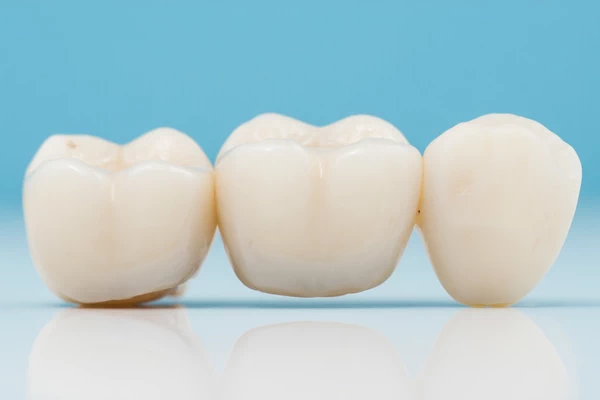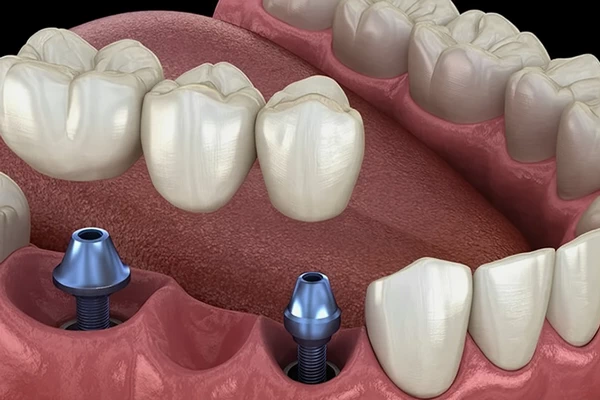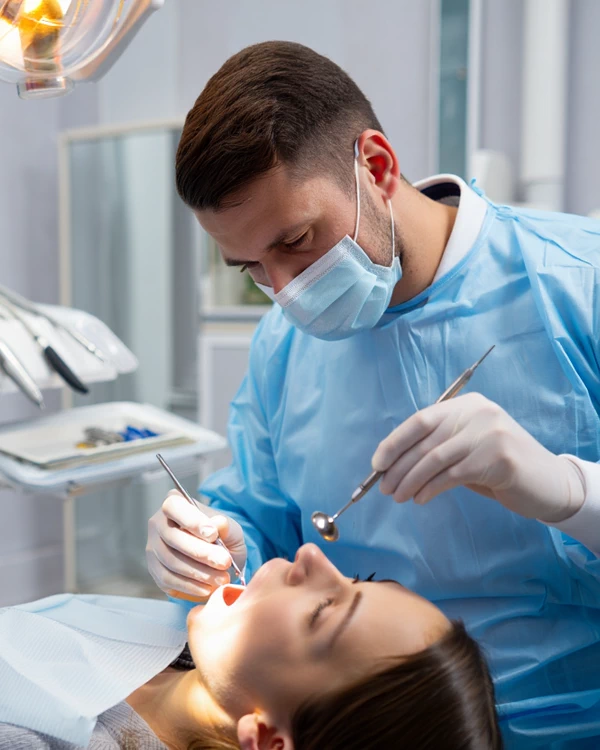Dental Bridges in Alexandria, VA
Are you experiencing gaps in your teeth due to tooth loss? Whether the loss was long ago or unexpected, a dental bridges can effectively fill the gap.
Dr. Benjamin Watson, with practices in Alexandria, Virginia, is ready to provide expert care and restore the beauty of your smile.
Schedule an appointment
Why might a dental bridges be a good solution?
- Restoring a Lost Smile
Bridges are an effective solution for restoring one or more adjacent missing teeth. If your teeth are damaged or decayed and you’re not yet ready for a bridge, our experienced dentists offer emergency treatment, including tooth extraction if necessary. - A Personalized Approach to Each Patient
At Alexandria dentist we begin treatment by creating precise 3D models of your jaw using the state-of-the-art VATECH i3 imaging system. This allows us to create a detailed plan for the installation of your new bridge, which will be fabricated in our trusted partner’s dental laboratory. We will help you choose the best option—a traditional bridge or an implant-supported bridge—to achieve the best possible outcome. - A Life Full of Confidence
Dental bridges not only restore the functionality of your jaw, making it easier to speak and eat, but also significantly reduce the risk of future tooth loss and bite deformities. With a beautiful, restored smile, you will feel more confident in any situation.

Contact Alexandria Dentist today!
To schedule an appointment with our dentists
What types of dental bridges might be right for you?

Traditional Dental Bridge
This is a solution for restoring a dental arch when several adjacent teeth are missing. The design consists of two crowns secured to pre-treated abutment teeth, with a pontic (artificial teeth) placed between them. Unlike implant-supported bridges, this option does not prevent jawbone resorption, but it can be implemented more quickly and at a lower cost.

Implant-Supported Dental Bridge
An implant-supported bridge is secured not with crowns, but with dental implants, which are small metal posts. These implants can prevent bone loss, making them an excellent investment in oral health. Our dentists can install both dental implants and bridges, eliminating the need for external specialists.
How can I pay for a dental bridge?
- Insurance Options
Dental insurance typically covers dental bridges, but not dental implants. Our clinic partners with a wide range of insurance companies. To ensure your insurance coverage is accepted, we offer a simple verification process. - Convenient Payment Options
We believe cost shouldn’t be a barrier to a beautiful and healthy smile. We accept payments through CareCredit®, allowing you to pay in small monthly installments. Find out your credit limit without worrying about it being lowered. - Cash or credit card payment options
If insurance coverage is unavailable, our Alexandria patients can pay for dental bridges in cash. You can also use a line of credit to conveniently pay for treatment.
What happens during the placement of a traditional dental bridge?
- Consultation and examination: The dentist evaluates the condition of the teeth, gums, and bone tissue, usually using X-rays, to identify any hidden problems.
- Preparation of the abutment teeth: Part of the enamel and dentin is removed from the abutment teeth to create space for the crowns that support the bridge. It is important to preserve as much healthy tissue as possible.
- Impression: An impression of the teeth is sent to a laboratory to create a model of the bridge. A temporary bridge is placed on the patient.
- Try-in and cementation: The permanent bridge is tried in to check the fit, bite, and comfort. If all is well, the bridge is cemented to the abutment teeth, polished, and the bite is rechecked.
- Care and hygiene: The patient is given instructions on caring for the bridge, including brushing, flossing, and regular dental checkups. Proper maintenance prolongs the life of the bridge.

What happens during the placement of an implant-supported bridge?
Restoring the integrity of the dental arch with an implant-supported bridge is a multi-stage procedure that requires careful planning.
Initial consultation and strategy development:
The dentist conducts a visual examination, collects information about the patient’s health, and orders an X-ray or CT scan to assess the bone tissue. Based on this information, an optimal treatment plan is developed, the number of implants required is determined, and the type of bridge is selected. The possible materials and cost of the bridge are discussed.
Surgical implant placement:
Under local or general anesthesia, the surgeon inserts titanium implants into the jawbone. The gums are then sutured, and the implants are left in place for 3 to 6 months to allow for successful osseointegration—the process of fusion with the bone. In some cases, a temporary prosthesis may be installed for aesthetic reasons.
Healing and preparation for prosthetic restoration:
After the implants have healed, a minor surgical procedure is performed to expose them. Gum formers are placed on the implants, allowing the natural gum contour to be formed within one to two weeks.
Impressions and prosthesis fabrication:
To create a custom-made dental bridge that best matches the patient’s anatomy, impressions of the jaws are taken. The bridge is fabricated in a dental laboratory using metal-ceramic, zirconium dioxide, or E-max ceramic. Abutments—the elements that connect the implants and the bridge—are also fabricated.
Try-in and final fixation of the bridge:
The completed dental bridge is tried in the mouth, assessing the accuracy of its fit and adherence to the gums. After any necessary adjustments, the bridge is securely cemented to the abutments using dental cement or screws. Screw fixation is preferred because it allows the bridge to be removed for hygiene procedures or repairs, if necessary.
Postoperative care recommendations:
To maintain oral health, it is essential to maintain proper oral hygiene: regularly brush your teeth with a soft toothbrush, floss, and use a water flosser. Regular visits to the dentist for professional cleanings and monitoring of the implants and bridge are equally important.
Why choose us?
Patients who seek dental bridges at Alexandria Dentist report a significant increase in comfort in their daily lives. Restoring dental continuity not only improves the aesthetics of their smile but also restores functionality, makes chewing easier, and reduces the risk of gum disease and jaw joint problems. Furthermore, dental bridges play a vital role in preventing the movement of adjacent teeth and maintaining a proper bite.
Alexandria Dentist employs outstanding dentists with extensive experience in dental bridges. Our experts continually enhance their skills and knowledge to stay current with the latest trends in dentistry. We use cutting-edge equipment and innovative technologies to ensure our patients receive the most comfortable and effective treatment possible.

Make an appointment
325 South Fairfax Street Alexandria VA 22314
703-255-8900
Opening Hours
Mo-Fr 8:00 am – 5:00 pm
Sa 9:30 am – 3:00 pm
